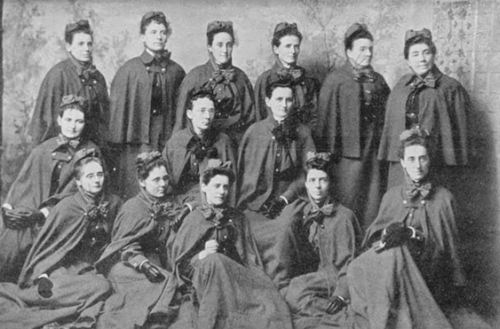The management and staff of the Glebe Hospital for Sick Children presented RPA-trained nursing sister Anna Garden with an illuminated address and a purse of sovereigns when she took six months’ leave to join the Second Contingent sent to the Boer War. Determined to go and willing to pay her own passage, Anna was a last-minute addition to other Army Nursing Service Reservists already selected. The women, who were farewelled with a Mayoress’s reception at Sydney Town Hall, were viewed with suspicion by some in the medical profession who maintained they were untrained in warfare and were looking for husbands. On 17 January 1900 they sailed through the Heads on the Moravian (together with 94 men, 52 horses, 12 carts and five ambulance wagons). Added to those aboard the steamers Southern Cross and Surrey the total contingent was 733 personnel plus 704 horses, at that time the largest military deployment to leave Australia on one day.
After landing at The Cape the nurses travelled by train to Bloemfontein through a landscape scarred by recent fighting: newly dug graves, carcasses of horses, blown-up bridges and destroyed fencing. Anna Garden nursed a soldier who was too badly injured to be moved into town, but by August 1900 she herself was convalescing in the Bloemfontein Hospital after contracting typhoid. She subsequently travelled to England where she was decorated by Queen Alexandra. In October 1901 she returned on the Arcadia to Sydney to live with her widowed mother and unmarried sisters in the family home Muiryshade, 7 Harrow Rd Stanmore. Their local church was St Enoch’s Presbyterian in Newtown. Anna worked as sister-in-charge at Camden Children’s Hospital, sister at the Royal Alexandra Hospital for Children, and sister-in-charge of the District Nursing Association (of which she was made a Life Member).
Anna Garden was the eldest daughter of Olivia Kemp and John Gardiner who married at St Andrew’s Scots Church on 22 December 1851. Born at Forres in northern Scotland, John became an elder of the Presbyterian Church. He had arrived on the St Vincent in 1844 as 20-year-old assisted immigrant John Garden, a surname he reverted to in 1890 after years of being known as ‘Gardiner’. This caused a deal of confusion in public records and within the family, some taking up the hyphenated ‘Gardiner-Garden’ and others dropping ‘Gardiner’ altogether.

In December 1851 John Gardiner joined the Board of National Education. His first posting was to Clarence Town. In 1856 he was transferred from William St Public to Fort St Model School as its second headmaster. Three years later he was appointed a district inspector and then a metropolitan inspector and an examiner before, in 1881, becoming Chief Examiner at an annual salary of £750, retiring in 1889 after 38 years’ service in public education. Gardiner’s Analysis of Sentences, first published in 1873, was a standard textbook for teachers.
John Gardiner-Garden died aged 76 on 28 April 1899 at his Stanmore home. His widow, Olive Gardiner-Garden [sic], collapsed aged 69 on 3 August 1903 while seated with her daughter Mabel on the train platform at Parramatta, and was buried at Rookwood with her husband and their deceased children William Thomson (1857- 64), John Wilkins (1860-64), Richard Thomas (1861-64) and Jane Camilla (1873-4). The three boys had died of scarlet fever over a period of four days at their Cleveland St Redfern home.
Oldest son Francis William, born at Clarence Town on 5 December 1853, followed his father into the teaching profession, beginning in 1868 as a pupil-teacher at Cleveland St. He was transferred to Singleton, Fort St and Albury before being appointed headmaster at Summer Hill Superior. Frank died in January 1906, a month after retiring because of ill health.
Andrew Smith Gardiner-Garden (1863-1940) was also an educator, beginning in 1878 as a pupil-teacher at Marrickville. He taught for about a month in 1880 at Glebe Boys before being sent to Macdonaldtown. In 1885 he was temporarily in charge at Pennant Hills from where he moved to Birchgrove, Chatsworth Island on the Clarence River, and Broughton Creek (Berry) before his appointment in 1901 as headmaster of Mortdale Public. By 1927 he was at Brookvale.
Son and architect Hubert McBain (born 1867) and public servant Allan Johnstone (born 1870) both died in 1937. Margaret Wilhelmina (born 1866) was sharing a house (60 Murdoch St Mosman) with her sister Anna at the time of her death in 1946. Living elsewhere in Mosman was Mabel Olive (born 1871) who died in 1957. Also known as ‘Annie’ or ‘Nan’, Anna Garden died at Neutral Bay on 21 January 1951 and was cremated at Northern Suburbs.
Sources: Australian Town & Country Journal 27.1.1900; Australian War Memorial website; bwm.org.au/site/Nurses.php; Clarence & Richmond Examiner 9.5.1899; Evening News 12.1.1900; Hipsley, P L The Early History of the Royal Alexandra Hospital for Children 1880 to 1905; NSW cemetery records; NSW electoral rolls; NSW Government Gazette 25.8.1933; NSW registry of births, deaths, marriages; Oz-Boer database; Richmond River Herald 30.7.1937; Sands Directories; Singleton Argus 30.1.1906; State Records NSW immigration and probate records, teachers’ rolls; Sydney Mail & NSW Advertiser 6.5.1899, 12.10.1901; Sydney Morning Herald 29.4.1899, 8.1.1900, 16.1.1900, 17.1.1900, 29.5.1900, 24.8.1900, 11.8.1901, 5.10.1901, 6.8.1903, 22.1.1951.
To read more about Glebe’s Hospital for Sick Children, see https://www.glebesociety.org.au/?socialhistory=sydney-hospital-for-sick-children-glebe-1880-1906.









There are no comments yet. Please leave yours.